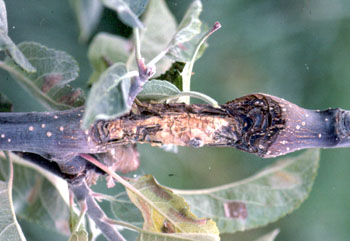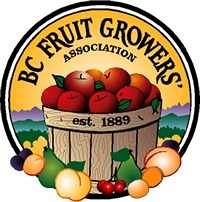European Canker
General Description
European canker is a disease of apple and pear caused by the fungus Nectria galligena. It is severe in coastal areas, and has been a problem in some interior orchards. The disease has been introduced to orchards on nursery stock grown in wet climate areas. At the time of purchase infected nursery stock may have no obvious symptoms of canker, but cankers develop during the first year after planting. While the disease is less aggressive in the dry climate of the Okanagan/Similkameen valleys, natural spread does occur and it is capable of causing considerable damage. Spores produced in cankers may also cause a fruit rot similar to bull's-eye rot.
Symptoms
The first sign of canker is a reddish-brown spot around a leaf scar, spur or pruning wound, usually in late spring or early summer. The canker develops quickly with ring shaped cracks forming in the bark, which may appear swollen. If the canker girdles the trunk or branch, shoots above the canker die. The canker usually stops growing after one year. A ridge or collar of healthy tissue walls off the canker. Young cankers produce small, whitish fruiting bodies. Older cankers may produce orange-red fruiting bodies. European canker can sometimes be confused with anthracnose canker.
 |
| European canker on apple branch. (BCMA) |
Life Cycle
Spores from new cankers are spread primarily by rain or overhead irrigation. New infections are thought to occur mainly in the autumn through leaf scars, with symptoms appearing the following spring. Older cankers produce airborne spores (ascospores) that can initiate new infections at a distance from the source. The airborne spores function mainly to initiate new infections, while the water-borne spores serve to intensify the disease in trees that are already infected.
Management
Cultural Control
-
Prune out diseased wood. On young trees this often means pulling out the tree or pruning it back severely.
-
Nursery trees should be examined carefully for symptoms of the disease at planting and again the following spring. Trees with cankers should be returned to the nursery for replacement or discarded.
Chemical Control
There are no fungicides registered for control of European canker in Canada. Fungicides applied for other diseases such as apple scab may help to reduce the numbers of new infections. Limited local data indicate that using Inspire Super for scab or mildew, or Senator for mildew, may also provide some preventative suppression of fungal cankers.
Updated February, 2017
